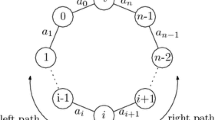Abstract
Recently, Hazan and Krauthgamer showed [12] that if, for a fixed small ε, an ε-best ε-approximate Nash equilibrium can be found in polynomial time in two-player games, then it is also possible to find a planted clique in G n, 1/2 of size C logn, where C is a large fixed constant independent of ε. In this paper, we extend their result to show that if an ε-best ε-approximate equilibrium can be efficiently found for arbitrarily small ε > 0, then one can detect the presence of a planted clique of size (2 + δ) logn in G n, 1/2 in polynomial time for arbitrarily small δ > 0. Our result is optimal in the sense that graphs in G n, 1/2 have cliques of size (2 − o(1)) logn with high probability.
Preview
Unable to display preview. Download preview PDF.
Similar content being viewed by others
References
Alon, N., Kahale, N.: A spectral technique for coloring random 3-colorable graphs. SIAM Journal on Computation 26(6), 1733–1748 (1997)
Alon, N., Krivelevich, M., Sudakov, B.: Finding a large hidden clique in a random graph. Random Structures and Algorithms 13(3-4), 457–466 (1998)
Alon, N., Spencer, J.: The Probabilistic Method. Wiley, Chichester (1992)
Chen, X., Deng, X., Teng, S.-H.: Computing Nash equilibria: Approximation and smoothed complexity. In: FOCS 2006: Proceedings of the 47th Annual IEEE Symposium on Foundations of Computer Science, USA, pp. 604–612 (2006)
Conitzer, V., Sandholm, T.: Complexity Results about Nash Equilibria. In: 18th International Joint Conference on Artificial Intelligence, pp. 765–771 (2003)
Daskalakis, C., Goldberg, P.W., Papadimitriou, C.H.: The complexity of computing a Nash equilibrium. In: STOC 2006: Proceedings of the 38th annual ACM Symposium on Theory of computing, USA, pp. 71–78 (2006)
Feige, U.: Relations between average case complexity and approximation complexity. In: STOC 2002: Proceedings of the 34th annual ACM Symposium on Theory of Computing, pp. 534–543 (2002)
Feige, U., Ofek, E.: Easily refutable subformulas of large random 3CNF formulas. Theory of Computing 3(1), 25–43 (2007)
Gilboa, I., Zemel, E.: Nash and correlated equilibria: Some complexity considerations. Games and Economic Behavior 1(1), 80–93 (1989)
Jerrum, M.: Large Cliques Elude the Metropolis Process. Random Structures and Algorithms 3(4), 347–359 (1992)
Juels, A., Peinado, M.: Hiding Cliques for Cryptographic Security. Designs, Codes and Cryptography 20(3), 269–280 (2000)
Hazan, E., Krauthgamer, R.: How hard is it to approximate the best Nash equilibrium? In: ACM-SIAM Symposium on Discrete Algorithms, USA, pp. 720–727 (2009)
Kučera, L.: Expected Complexity of Graph Partitioning Problems. Discrete Applied Mathematics 57(2-3), 193–212 (1995)
Lipton, R.J., Markakis, E., Mehta, A.: Playing large games using simple strategies. In: 4th ACM conference on Electronic commerce, USA, pp. 36–41 (2003)
Tsaknakis, H., Spirakis, P.G.: An Optimization Approach for Approximate Nash Equilibria. In: Deng, X., Graham, F.C. (eds.) WINE 2007. LNCS, vol. 4858, pp. 42–56. Springer, Heidelberg (2007)
Author information
Authors and Affiliations
Editor information
Editors and Affiliations
Rights and permissions
Copyright information
© 2009 Springer-Verlag Berlin Heidelberg
About this paper
Cite this paper
Minder, L., Vilenchik, D. (2009). Small Clique Detection and Approximate Nash Equilibria. In: Dinur, I., Jansen, K., Naor, J., Rolim, J. (eds) Approximation, Randomization, and Combinatorial Optimization. Algorithms and Techniques. APPROX RANDOM 2009 2009. Lecture Notes in Computer Science, vol 5687. Springer, Berlin, Heidelberg. https://doi.org/10.1007/978-3-642-03685-9_50
Download citation
DOI: https://doi.org/10.1007/978-3-642-03685-9_50
Publisher Name: Springer, Berlin, Heidelberg
Print ISBN: 978-3-642-03684-2
Online ISBN: 978-3-642-03685-9
eBook Packages: Computer ScienceComputer Science (R0)




